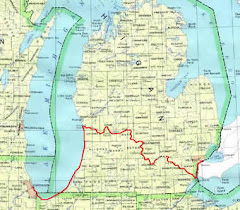
Like Hugh Heward in 1790, I kept a journal of my 1948 canoe trip only I called it a Canoe Trip Log. After studying Hugh's elegant journal I am a little ashamed of mine. Here are some samples:
"Sat. 30 July: O515 left civilization between railroad and power line. Paddled 1/2 hour to Homestretch Island. Lost big muskie by horsing...caught 16" pike (Northern pike, the natives called them "jackfish") 10 minutes later Ned caught big pike at island. Ate breakfast at 1000. Canoes lashed together for rough water. Rained in at Hook Island .Long haul in rough water (We are on Rainy Lake) to Standingstone Point. Spent night. Caught pike".
" Windbound Sun July 31 Took refuge on island off point. Noon meal on island...swim. Camp Sun night..2 pike".
"0900 on way Mon AM. (Aug 1) Big bass..largemouth. Hector (Ken) caught pike. Stopped for lunch. John no longer virgin...his first pike. Camped Mon night on Sphene Lake after portage from Rainy Lake. (RAIN), Hamburgers, fried onions, macaroni and cheese and cocoa for supper...saw two deer."
"Picture #4 at Devils Cascade, #5 at Sphene Lake. Picture #6 at first portage of Manitou River. Camped above rapids after 2 portages, 3 wades & 2 paddle-through rapids.
Two canoes and four guys passed us. They are going to go down the Albany."
Very soon I tightened up the herky-jerky narrative and quit counting fish and describing menus. In re-reading this log I have enjoyed reliving some of those upstream struggles of six decades ago.
Here is a sample of Hugh's journal. On April 23 the party (Hugh and seven French-Canadian paddlers in two 20 foot birchbark canoes) encountered some Indians spearing sturgeon (near present day Onondaga). He called them "an ill looking band of about 12". They traded some tobacco for a sturgeon and took off when they saw more Indians coming. They ran the rapids at present day Eaton Rapids and kept going and camped probably about where Burchfield County Park is today.
"Saturday Apl 24th 1790. Refited our Cannots with Gum & set off passed a Rapid in about an hour (Dimondale) after which high broken Land & some pine Trees the banks of Red land from thence came to a River from the East (Red Cedar) & a little lower two cabins of Indians from Sagana (North Lansing) they were providing Cannots for their Departure the course to this Time nearly Nore West by Nore from thence high broken Land & some pine & Cedar about 11 oClock came to an island in the Middle of the River & a long Rapid & afterwards another Island about Mid Day. (Delta Mills) Dined the Course West Nore West & came to another Island afterwards three Small Islands and some Pine trees on each Side of the River & high Rocks on the North (Grand Ledge) & a small Run of Water from the South (Sandstone Creek) after which another small Island & and a long and pleasant drift of an equal and strong Current the Banks high but the Beach level & Gravelly bottom to a long but not very strong Rapid & to another Island the Course West by North to again high Banks to the North to another Island from thence to four others all together following from here a high Sandy Bank with some pine Trees on the south side after which a Large Island & two small ones following afterwards three Small Islands & two small meadows to North this last Course nearly West heavy Wood on all Sides Encamped Opposite an Island" (In Portland State Game Area near Sebawa Corners).
I took the time to insert punctuation at the logical places when I was doing my research in 1989 and 1990. That made it easier to follow his route on maps and along the river.
This is the day's paddle commemorated by the annual 50 mile Hugh Heward Challenge. This year's Challenge runs from Dimondale to Portland on Saturday April 25 2009.
NEXT: Shooting rapids.


No comments:
Post a Comment